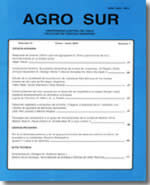Preliminary study of groundwater quality in the Tenth Región of Chile
Main Article Content
Abstract
The present study had the main objective to investigate the influence of deep well construction type (with sealing and without sealing of aquifer strata) on quality of groundwater. For this purpose, 5 deep wells with sealed aquifers were chosen and 5 without sealing of these. The 10 wells were distributed in the provinces of Valdivia, Osorno and Llanquihue, Chile. Each of the sealed wells had located in their proximity (on the average 400 m) a well of traditional construction. Water was evaluated for human drink, for animal and irrigation use, mainly through chilean norms of quality. Finally, related to water quality, the influence of season-time was investigated. There were carried out measurements of temperature, pH, electric conductivity, nitrates, nitrites, ammonium, phosphate, calcium, magnesium, sodium, potassium, aluminium, iron, manganese, copper and zinc; also total hardness of water, sodium-absorption ratio and soluble-sodium percentage, were calculated. Faecal coliforms, total coliforms, Escherichia coli, and total bacterial count, were also determined. Results indicated that aquifer seals have no effect on microbiological quality of groundwater. Under given conditions of the present study, it was also not possible to conclude the effectiveness of the bentonite seal of aquifers related to chemical quality of groundwater. Its use as human drinkable water would present objections, mainly in Osorno-city located wells, determined by ammonium and manganese levels (according to chilean norms), by phosphate levels (according to OMS recommendation) and aluminium concentrations (according to AWWA). Cases with microbiological pollution of groundwater were also reported, which without previuos treatment could not be recommended for human drink. Considering chilean norms, its use as animal drinkable water presented the same objections as those indicated for human drink. Besides, under the same norms, studied groundwaters had a good quality for irrigation use, excepting those of Osorno-wells, with exceeded manganese levels. The season-time had influence on temperature, phosphate, calcium, soluble-sodium percentage, aluminium, iron and zinc concentrations. The rest of analysed parameters didn't show variations along the three sampling dates.

